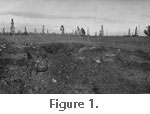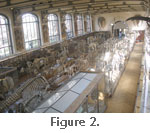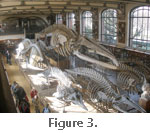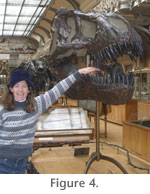
INTO FOCUS: Museums and Their Exhibits
Paleontologists generally love museums of natural history. Nearly every one of them can tell stories of how their lives and careers were positively influenced by a museum or how they got a great new idea while visiting one. Many of us even work in such museums, and some museums are branches of academic departments or institutes. Most people who visit museums, in fact, are intrigued by the paleontology exhibits (especially dinosaurs, naturally). In other words, museums of natural history around the world are integral parts of paleontology, if not of every paleontologist’s life. We owe them much gratitude for displaying our science so consistently, if not so thoroughly.
All museums are faced with the question of how to show off their proud possessions. All agree, as do funding agencies, teachers’ groups, and professional exhibition developers, that the educational potential is the most important value to build on. So we see in recent decades some very fancy educational exhibits with explanations, commonly going into great detail with graphs and illustrations, all making the fossils quite clear and understandable. They do their educational job. For these kinds of exhibits, museums can receive large amounts of funding. And funding is of primary importance to museums, as they now must compete for people’s attendance with an increasing number of fantasy lands like Disneyland, thrill parks like Magic Mountain, nature parks like Marineland, or even just the movies. This competition almost makes museums obsolete, so the museums try to counter these with great new and rotating exhibits. Of course these are important, especially in paleontology, for if anything can capture the joy of science for young people and adults as well, it is paleontology. Yet, I wonder. It’s not what I experienced growing up and it’s not what I have seen while wandering museums on six continents. Let me give you an opinion then that may differ from these newer views, but is not totally incompatible with them.
My own trip back through time began when I was about 7
or 8 years old. I visited the
Los Angeles County Museum of Natural History in Exposition Park, not
far from my home. I still remember the Rancho La Brea room, with fossils
from the tar pits over on Wilshire Blvd. Dark colored bones were
everywhere, a profusion of disarticulated and mounted skeletons that
took my breath away. I could not imagine that there were so many
fossils, most of them different from one another and obviously from
different kinds of animals. Even branches and logs were laid out along
the center of the hall. All of this made sense to me even though the
animals were like nothing I had ever seen or imagined. I was in a real
state of excitement among those bones and the smell of residual tar that
penetrated their every nook and cranny. I felt close to that ancient
world. The story was made a bit clearer to me by an amazing, huge mural
at one end of the room showing giant scavenging birds (Teratornis)
perched on branches of a scraggly old tree overlooking a
sabre tooth cat (Smilodon californicus, now the California
state fossil) eyeing several giant ground slots (Paramylodon harlani).
This, of course, was one of the famous
Charles R. Knight murals that have influenced several generations of
paleontologists to take up the trade. None of these bones or other
fossils or the mural was burdened with lots of explanation. They were
all exhibited in such a way that every case or mount contained the
thrill of discovery. I felt like there was a lot yet to do and that the
answers were still incompletely known. I knew I wanted to be part of
that excitement. As exciting as the mural was, the bones thrilled me
even more as I roamed among those cases and the mounted skeletons all
barely labeled at all. I wasn't just thrilled at the sight of these strange
animals that thousands of years ago walked over the same ground where I
lived, but my imagination leaped to recreate in my mind what the
landscape must have been like beyond the bounds of Knight’s mural and
what those animals actually did there.
 I
begged my father to go to the
tar pits, and when we arrived, it was a rather unkempt grassy
square block with open and accessible pits of asphalt (Figure
1). I saw the tar-encrusted body of a song-bird lying near the shore
of one of the tar pit lakes, and I could picture in my mind exactly what
happened to all the thousands of individuals and species of animals and
plants that accumulated in the pits over the millennia and were now
displayed in the La Brea room at LACM. Back at the Museum, I wondered
about the life and death of this enormous number of animals. I could see
the dire wolves (C. dirus) on the edge of the tar pools waiting
for the ground sloths, horses and mammoths stuck in the tar to tire and
stop struggling so the wolves could leap from shore to the dying
animals’ backs for a meal of their own. That was a mistake for many of
them, of course, for they are the most abundant vertebrate in the pits.
I could easily picture those taphonomic moments in my mind’s eye, even
though that word had not yet become common in paleontology and I
certainly hadn’t heard of it. In fact, I hadn’t heard very much about
paleontology at all! I remembered the
skeleton of a woman, a Native American, found in one pit, and I
wondered if she, like me, crept carefully to the edge of the water, but
not knowing about the asphalt or maybe seeking some of it to repair a
basket, became trapped and preserved for posterity. In some ways, I
admired her sacrifice, for it added much to my own life although I was
always sorry she died the way I assumed. But maybe, it occurred
to me, she was thrown into the pit by an irate relative, probably a
husband, in a sort of early Holocene murder scene. I didn’t know, but I
sought evidence for which of these hypotheses might be right on her
skeleton. Alas, I could see nothing that told me the answer, and I still
wonder how she died (apparently there’s not many of her bones and the
exhibits were a bit contrived, but no longer on display at the Page
Museum). Of course I didn’t think in terms of hypotheses then, but
clearly my imagination generated alternatives for me to puzzle over. I
returned to the museum and the tar pits at every opportunity, and every
time I came away with lots of excitement and many new if not great
ideas. Those ideas eventually led me to tell everyone around that I
wanted to be a paleontologist when I grew up, and I did.
I
begged my father to go to the
tar pits, and when we arrived, it was a rather unkempt grassy
square block with open and accessible pits of asphalt (Figure
1). I saw the tar-encrusted body of a song-bird lying near the shore
of one of the tar pit lakes, and I could picture in my mind exactly what
happened to all the thousands of individuals and species of animals and
plants that accumulated in the pits over the millennia and were now
displayed in the La Brea room at LACM. Back at the Museum, I wondered
about the life and death of this enormous number of animals. I could see
the dire wolves (C. dirus) on the edge of the tar pools waiting
for the ground sloths, horses and mammoths stuck in the tar to tire and
stop struggling so the wolves could leap from shore to the dying
animals’ backs for a meal of their own. That was a mistake for many of
them, of course, for they are the most abundant vertebrate in the pits.
I could easily picture those taphonomic moments in my mind’s eye, even
though that word had not yet become common in paleontology and I
certainly hadn’t heard of it. In fact, I hadn’t heard very much about
paleontology at all! I remembered the
skeleton of a woman, a Native American, found in one pit, and I
wondered if she, like me, crept carefully to the edge of the water, but
not knowing about the asphalt or maybe seeking some of it to repair a
basket, became trapped and preserved for posterity. In some ways, I
admired her sacrifice, for it added much to my own life although I was
always sorry she died the way I assumed. But maybe, it occurred
to me, she was thrown into the pit by an irate relative, probably a
husband, in a sort of early Holocene murder scene. I didn’t know, but I
sought evidence for which of these hypotheses might be right on her
skeleton. Alas, I could see nothing that told me the answer, and I still
wonder how she died (apparently there’s not many of her bones and the
exhibits were a bit contrived, but no longer on display at the Page
Museum). Of course I didn’t think in terms of hypotheses then, but
clearly my imagination generated alternatives for me to puzzle over. I
returned to the museum and the tar pits at every opportunity, and every
time I came away with lots of excitement and many new if not great
ideas. Those ideas eventually led me to tell everyone around that I
wanted to be a paleontologist when I grew up, and I did.
Now when I go back to the tar pits, the grounds are manicured with fancy plants, cut grass, impressive concrete sculptures of ancient animals rise from the largest of the tar lakes, the Los Angeles County Museum of Art (whose basement, like those many of the fancy buildings near the tar pits, needs careful attention as tar threatens to pierce it) has usurped a corner of the park, and the wonderful George C. Page Museum fossil museum now sits, as it should, between the major tar pits. However, I was happy to see a vestige of those earlier times—tar bubbling up through the green grass, waiting to trap some careless bug or bird or get some little kid dirty and sticky. My mind was imaging a lot of things once again, but in a much more restricted environment than I had remembered some 50 years ago. Of course, the area was nothing like it was when the pits trapped these magnificent animals thousands of years ago anyway. Today’s kid has a much larger problem to eliminate the traffic, modern edifices, crowds of people, trash, and urban noise from his mind so that his imagination can take off with an entirely different Pleistocene scene. But it is still possible, thankfully.
 Not
long ago, I wandered around
Les Galeries de Paléontologie et d’Anatomie comparée, one of several
large museum buildings of the
Muséum national d’Histoire naturelle just off the Seine (Left Bank)
in Paris, looking at more than ten thousand skeletons, skulls, bones,
and dissections, all arranged in Victorian symmetry and orderliness. Two
full skeletons of giraffes, placed one on each side of the gallery,
whale skulls balanced by massiveness on the wall, and all the others
arranged in some ancient systematic order spreading out to the right and
left and for what seemed an infinite distance down the gallery (Figure
2, Figure 3).
Not
long ago, I wandered around
Les Galeries de Paléontologie et d’Anatomie comparée, one of several
large museum buildings of the
Muséum national d’Histoire naturelle just off the Seine (Left Bank)
in Paris, looking at more than ten thousand skeletons, skulls, bones,
and dissections, all arranged in Victorian symmetry and orderliness. Two
full skeletons of giraffes, placed one on each side of the gallery,
whale skulls balanced by massiveness on the wall, and all the others
arranged in some ancient systematic order spreading out to the right and
left and for what seemed an infinite distance down the gallery (Figure
2, Figure 3).
 One
floor above the comparative anatomy exhibits were the paleontology
specimens (Figure 4). Again,
fossil vertebrates arranged more or less in stratigraphic order, all
facing east, with invertebrates and microfossils in cases around a
balcony in the hall. I was in ecstasy on both floors! All those bones
and fossils made my imagination whirl once again. What mysteries lay in
that place? What excitement! I was in my element again. Most of you have
been there in Paris too, or should go. Don’t expect much in the way of
educational materials. It remains one of the few old-style museum
exhibits where the specimens matter. Indeed, the Gallery captured the
attention of the many visitors who seemed amazed by the variety and
variation of all those bones—150 skulls of one kind of mouse, an
assemblage of whales from the smallest to the largest, human embryos in
various stages of development, horses, dogs and cats, and as fascinating
as could be, conjoined twins of humans and other mammals. So much to
see, so little time.
One
floor above the comparative anatomy exhibits were the paleontology
specimens (Figure 4). Again,
fossil vertebrates arranged more or less in stratigraphic order, all
facing east, with invertebrates and microfossils in cases around a
balcony in the hall. I was in ecstasy on both floors! All those bones
and fossils made my imagination whirl once again. What mysteries lay in
that place? What excitement! I was in my element again. Most of you have
been there in Paris too, or should go. Don’t expect much in the way of
educational materials. It remains one of the few old-style museum
exhibits where the specimens matter. Indeed, the Gallery captured the
attention of the many visitors who seemed amazed by the variety and
variation of all those bones—150 skulls of one kind of mouse, an
assemblage of whales from the smallest to the largest, human embryos in
various stages of development, horses, dogs and cats, and as fascinating
as could be, conjoined twins of humans and other mammals. So much to
see, so little time.
 I
was drawn by that place and, of course, the City of Light, when choosing
my sabbatical site for 2005-06. I was lucky to have a wonderful host in
Dr. Marie-Thérèse Vénec-Peyré, a micropaleontologist, who provided all
sorts of intellectual excitement and all the resources of the
Muséum national d’Histoire naturelle. She also graciously showed me
how to get into
Les Galeries de Paléontologie et d’Anatomie comparée from the office
space, and I sneaked in there often, just to walk around and look at all
those specimens. Those Galleries remain fixed in a special place in my
mind. I was excited to think that now I would have all the time I needed
to explore it! Not true, it turned out, as a year is not enough time at
all. I must go back and find new steps, perhaps starting at the back or
at one side, and see what new ideas and excitement come of this.
I
was drawn by that place and, of course, the City of Light, when choosing
my sabbatical site for 2005-06. I was lucky to have a wonderful host in
Dr. Marie-Thérèse Vénec-Peyré, a micropaleontologist, who provided all
sorts of intellectual excitement and all the resources of the
Muséum national d’Histoire naturelle. She also graciously showed me
how to get into
Les Galeries de Paléontologie et d’Anatomie comparée from the office
space, and I sneaked in there often, just to walk around and look at all
those specimens. Those Galleries remain fixed in a special place in my
mind. I was excited to think that now I would have all the time I needed
to explore it! Not true, it turned out, as a year is not enough time at
all. I must go back and find new steps, perhaps starting at the back or
at one side, and see what new ideas and excitement come of this.
Other museums around the world fall someplace between those Galleries in Paris, including the newest and largest natural history exhibit in the nearby Grande Galerie de l’Evolution, a fantastic collection of materials from all parts of the world. The Grande Galerie, the pride of the Muséum national d’Histoire naturelle, has its remarkable elements. I love the parade of stuffed animals appearing to march in some orderly manner through the center of the place and the whale skeletons hanging above visitors, again with limited labeling. Elsewhere the exhibits remain outstanding but the explanations get more detailed and more complex. The kids, who stand in amazement along the parade or silently gaze upwards to see the whale, run right by these exhibits in the quest for items that excite them more. So it is with so many of our museums elsewhere in the world. Now the museums and the tar pits have become “educational” centers with elaborate explanations of evolution, geologic time, paleoenvironments, plate tectonics, etc, etc. Everything is well explained, leaving nothing to the imagination. They are very educational and I hate it.
I am a minimalist when it comes to museums and field sites too for that matter. I do not like a lot of educational text that explains it all or, worse, tries to explain it all. I am not an expert on anyone’s education but my own, and I’ll tell you that all that text and labeled illustrations robs me of the adventure that my mind generated while puzzling it all out in front of the bones. In Paris, I saw huge numbers of school children almost every day in the anatomical and paleontologic collections, sitting on the floor and drawing the specimens they saw. Yes, it was an assignment and their teachers helped them with a little instruction, or so it seemed to me, and they appeared to like the work. Very little explanation accompanied those bones in the exhibit, but the students were clearly learning a good deal without them. I hope their little imaginations ran away with them too, and that they could secretly envision the giraffe running across the veldt with the lion in pursuit or perhaps some other adventure.
While I am sure that we will never get rid of all the educational exhibits, and we shouldn’t, I think, but museums must rekindle the creativity and imaginations of people of all ages. Let’s have more exhibits where nothing more than the diversity and abundance of organisms or their parts (or really, anything else) can be seen and admired without detailed or complicated explanations. Leave room for self-generated discovery and excitement. It’s not hard to do, as some museums have indeed done such complementary displays. For example, the California Academy of Sciences in San Francisco some years ago had a display on skulls. A whole room was devoted to them in the Academy’s old facility, and one wall was covered with skulls of different creatures. Once again I felt excited and creative as soon as I walked in—imagination was working hard once again and the thrill was there. I had been captured by the wall and was compelled to read a bit of the explanations too. The Natural History Museum—London has its unique new Darwin Centre, which contains some 22 million specimens occupying 27 km of shelf space. It is the research collections of the museum and now people can tour it for free. I’ve only seen part of it but I’d bet that the adults and children will be mesmerized by the wonders of this collection. Again, not much in the way of labels but certainly a lot of mystery on those shelves. It should certainly get the people thinking about Earth’s diversity, if nothing else.
Good educators, I think, know that explanations without excitement and creativity are not the best way to teach people. While everyone gets excited by different things, museums certainly have an abundance and diversity of such items. All they need to do is lay them out in some exciting way. Those ways seem to me to include lots of specimens, lots of diversity, juxtaposed with just enough illustration to act as a point from which people can build their own discovery. There’s something deeply satisfying about discovering and creating our own realities. Creativity must be the primary goal for stimulating visitors but making that happen takes it own creative deep thought.
Most museums have educational and exhibits designers. These people work hard and come up with good ideas, but I often think that more paleontologists (and other scientists) should be intimately connected, as they sometimes are, with exhibit design. Once that happens, however, we seem to step in the wrong direction—we want to explain everything to the visitors. We are excited by our stuff, but remember they might not get it yet. They need to make those same discoveries themselves. So don’t explain. Remember how excited you were in a natural history museum. Remember why you got excited. Then work to get all those kids and their parents just as excited as you were. If I could do that, I’d take all those Rancho La Brea bones back out of their cabinets in the back rooms, and pile them high in the middle of some room where people can stand around and puzzle them out. I bet that would be an enormous amount of creative fun!